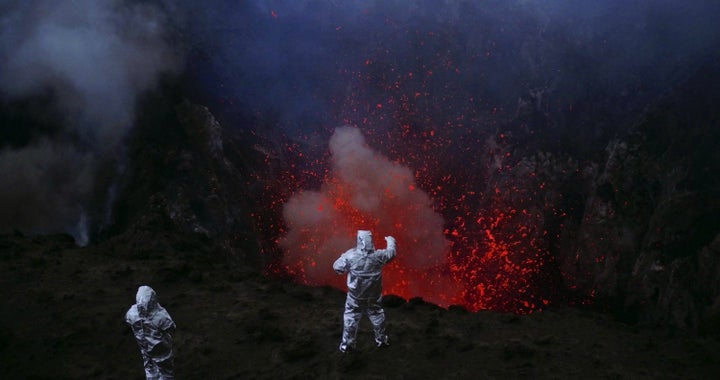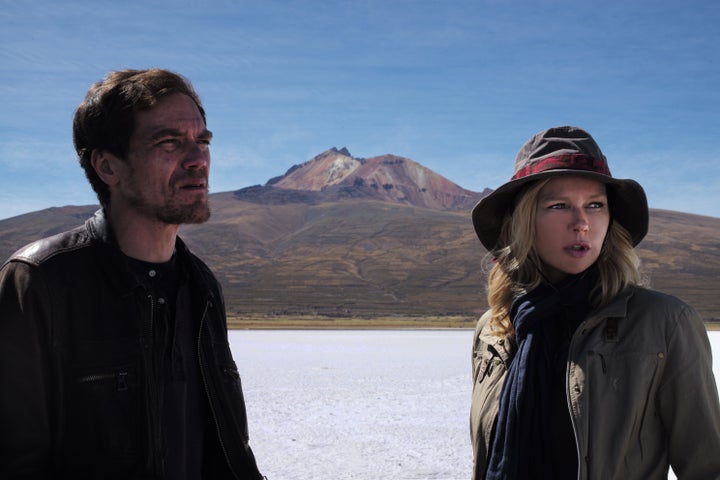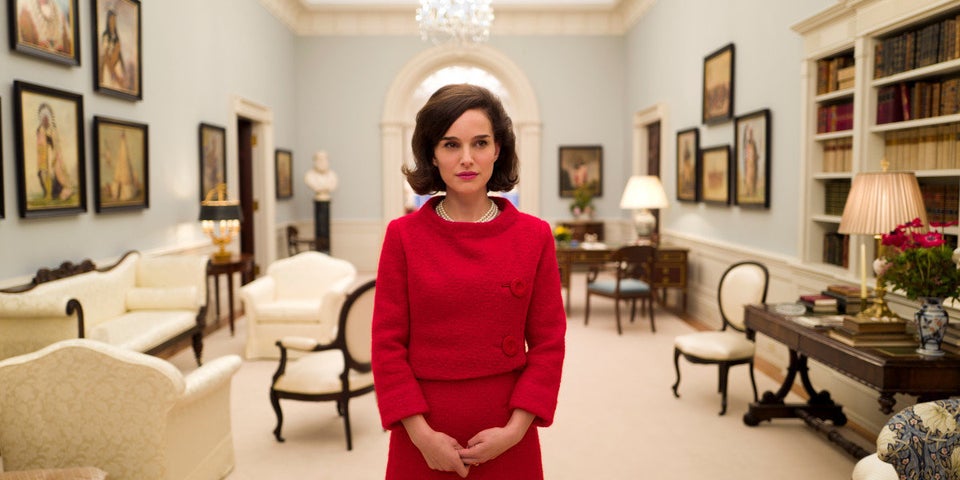
Fifty-four years into his career, Werner Herzog’s voice precedes him. To hear it in person is to encounter the distinct cadence that recently lent “Grizzly Man,” “Cave of Forgotten Dreams,” “Encounters at the End of the World” and “Into the Abyss” ― among many other films ― their charming philosophical sobriety. Herzog has a more expressive smile than most photos imply, and a warmer energy than the contents of his films suggest.
Herzog is in the mood for volcanoes this year. The German director had two lava-drenched movies at the Toronto Film Festival last month: “Into the Inferno,” a documentary that explores various cultures’ spiritual ties to these destructive hearths, and “Salt and Fire,” a thriller about two ecologists (Gael García Bernal and Veronica Ferres) who are kidnapped by a malicious businessman (Michael Shannon) and left to contend with a volcano on the brink of eruption. (Herzog’s other film this year, the documentary “Lo and Behold, Reveries of the Connected World,” treats the internet as another explosive volcano.)
“Into the Inferno” has just debuted on Netflix ― a surprising move in retrospect, considering one of the film’s publicists told me in Toronto that Herzog was very particular about the pulsing sound quality at the screenings. When I sat down with Herzog toward the end of the festival, I couldn’t help but sink into the surreality of hearing his famous lilt, the very one that has its own audio file embedded on his Wikipedia page. We discussed his travels to North Korea, where part of “Into the Inferno” is set, his love for Michael Shannon and the mystical properties of volcanoes. But you have to imagine Herzog’s answers in his voice ― it makes all the difference.
I heard you were very particular about the sound during “Into the Inferno” screenings, so I’m curious how that will translate to a Netflix release.
Well, when you are downloading it through Netflix, normally you watch it on your, let’s say, plasma screen at home. But what I see emerging is much better sound systems in your home, so it’s already happening. In two or three years, we’ll be much further advanced. But of course, in a big theater, what is important is that you feel the rumble physically under you and your seat is shivering. You know there’s something under you, and of course, inevitably, you will see an eruption. But that’s a privilege so far of real theater audiences’ experiences. Although you may download the film onto your smartphone, you will connect your smartphone to your plasma screen at home.
One hopes.
No one’s going to watch it on their smartphone, let’s face it ― and in particular a film like that. Although some films ― for example, “Grizzly Man” ― have such an intense drama in them, and it doesn’t really matter that much whether you see them in a gigantic theater or your screen at home. But this is a film which has extraordinary visual qualities, but at the same time, I keep saying, “Watch out for good sound.”

In thinking about the two documentaries you released this year, I wonder if volcanoes, for the subjects of “Into the Inferno,” have a similar spiritual and geological necessity that the internet does for a so-called developed country?
It’s an interesting connection you’re making. The internet film, “Lo and Behold,” is a deep anthropological look at what is going on and what creates these enormous and massive changes. I think that was somehow understood and actually wanted by the financiers, NetScout, a technological company that somehow keeps gigantic flows of data moving and looking out for anomalies. Probably by approaching me, they knew I was going into something that was not just technological. It’s the human impact of it. And in a way, the volcano film has a very humanistic view. How do people live and think and pray under the volcano? What sort of new gods and demons do they create? How do they form new mythologies?
Did you know going into it that the outcome would be various threads connecting the idea that spiritual properties are in some ways more vital than the scientific properties?
Well, it goes hand in hand because, of course, you can never figure out where the belief systems are going to lead you. North Korea is very enigmatic and we got very deep into it. But at the same time, you should not forget the central character in the film is Clive Oppenheimer, a volcanologist, and he has to combine the technical, measurable expertise with belief systems of people who ― for example, in Indonesia ― believe in demons and whatever. He is into crisis management, evacuating 500,000 people, and if you do not understand their belief systems, if you do not speak in the right tone and in the right metaphors to them, they would not evacuate. Having done a particular evacuation a few years ago saved easily 20,000 lives, so there’s a very serious side that has to do with science, but in finding also the right tone to convince people to get out fast. That means understanding the way they are thinking and having a vision of the volcano as the seat of a demon.

Tell me about your time in North Korea. At what point did you know you would film there?
Clive Oppenheimer, with whom I’ve been talking for quite a while about doing this film, and in a way it was triggered more seriously by his book, Eruptions that Shook the World, we started to talk very seriously, and at that time he had already started the combined scientific work between Cambridge University and North Korean volcanologists, studying a gigantic volcano at the Chinese border. I immediately thought, “If I could ever film in North Korea, that would be wonderful.” As the organization of the volcanologists was already established, it was not so hard to add to that a film crew. And of course the experience was unique. Everything was different from what we experience.
What surprised you the most?
Everything. You just walk around, and the country is so somehow isolated because of sanctions, but also because of the North Korean ideology of self-reliance, culturally, politically, militarily, economically. The country is in a unique isolation, in a way. Maybe “isolation” is not the right word, but it’s very, very fascinating. Whatever you do there is wonderful, and of course we knew about restrictions that we had. We had a clear idea of what was allowed to us and whatnot.
What was your reception as an outsider?
Very respectful. Really respectful. In a way, the North Koreans apparently knew about my films. The previous leader, Kim Jong-il, was a great movie fan. He wrote screenplays. So there was a cordial invitation and respect, and from my side I respected what out limitations were, although I had a way of talking them into wildly expanding what we were allowed.
What was your way?
I’m good at talking people into something. One of the main reasons for trust with them ― I didn’t understand it right away, but I sensed there was a very deep longing for reunification of Korea. I told them I come from a similar background, a divided country, and when politics gave up on reunification, Willy Brandt, whom I liked as a chancellor, declared in the Bundestag that the book of reunification was closed now. And I said, “Politics cannot do that. It’s more important than politics. It’s a deep, deep, deep historical longing and quest. Now it’s only the poets who can hold it together.” And I traveled on foot all the German border, with its neighboring countries, but all sinuations of the very line of the border ― Austria, Switzerland, France, Belgium, Holland, Luxembourg, Denmark ― and I said, “I have to hold it together like with a belt, or like with my arms.” And only four years later, the wall came down, to everyone’s surprise, even my surprise. The North Koreans were very, very deeply moved by that, and all of a sudden, I was allowed things that were not in our written directives.
“Into the Inferno” and “Salt and Fire” are interesting encapsulations of your career because I think you’ve always been drawn to the conflict and harmony between man and nature, between human society and the world beyond our immediate control. Do you think you’re reaching a point in your career where certain things are all-encompassing that way?
Maybe in a way, yes. Well, I’ve tried it all my life as a filmmaker, let’s face it. But “Salt and Fire,” of course, is as much about perception and understanding from which angle we are looking at something, like a famous mural in a cloister in Rome where you see a saint looking along a corridor, and when you move closer, all of a sudden the image changes and morphs into a landscape with boats and has been identified as the Strait of Messina. All of a sudden, there’s no saint anymore. And of course, in being exposed to the very strange, beautiful, hostile environments of salt flats in “Salt and Fire,” actually filmed in Bolivia, where the leading character is deliberately stranded with two blind local boys, it has this kind of confrontation with various beautiful but hostile environments. And how do you perceive? How do you look back at your life so far? The films were basically made back to back. There’s a cross-pollination about a volcano that might erupt.

You cast Michael Shannon in “Salt and Fire,” and you’ve spoken very fondly of him lately.
I think I’m the first one who put a leading part on his shoulders, in “My Son, My Son, What Have Ye Done?” I do this because, in my eyes, he’s the best of his generation. You can only think if there’s any other it would be Joaquin Pheonix, but we haven’t seen much of Joaquin unfortunately. I think he’s more active now. But Michael has an authority and a presence onscreen that is formidable, and a charisma which you cannot really grasp and describe. But, you see, you have to have a cast that creates chemistry, and that is Veronica Ferres, the German star, and Gael García Bernal, and another German actor, Lawrence Krauss, whose day job is actually a cosmologist. He’s a scientist who plays a villain. So it’s texture. It’s not just Michael Shannon ― he has to be embedded so that there is chemistry all of a sudden created.
Do you think the nature of the types of actors we cast in movies has changed?
No, not really, I think I have always made very fine discoveries. Let’s face it. Michael Shannon is not my discovery, but I saw very, very early on that there’s a very great one emerging.
Have you felt that way about other people before him?
Klaus Kinski, for example, who had done a lot of films, but lousy B-pictures, and only in very short appearances, because nobody could take him more than a day or two on a set. He was the ultimate pestilence. He would raise and throw tantrums. He was the most difficult ever walking this earth. Or, for example, Bruno S., in “The Enigma of Kasper Hauser” and “Stroszek,” a man who had never been in front of a camera before, and yet I saw there was something extraordinary about him. Or Nicolas Cage in “Bad Lieutenant.” I think they always have been at their best in my films.
Do you think you bring that out in them? What’s the collaboration that makes you feel that way?
Well, I think, in a way, I have it in me, and if I didn’t have it in my I shouldn’t make films.
That’s fair. Do you think there are a lot of directors working who are not as adept at bringing that out?
Well, sometimes what you see in the film industry is very often opportunistic. Put the best-selling or the most-wanted female actress together with the male actor who is more in vogue, and all of a sudden you end up with a film that has no chemistry between them. There are films that are dead on arrival because it has the greatest stars in the world in it and no chemistry between them. It happens.
Does it make you disenfranchised with the state of filmmaking and how financing works?
No, no, no, no. That’s part of what we do, and that’s part of the business. But sometimes business does not function. You can see it very clearly with Nicolas Cage. In “Bad Lieutenant,” I firmly believe he’s never been better. By the way, he’s publicly said it recently. That’s his all-time favorite film. That’s where he believes he was at his best. And my conviction is the same. In Kinski, an over-the-top B-actor in small roles, all of a sudden he becomes big doing “Aguirre, the Wrath of God” and “Fitzcarraldo” and some other films I did with him.
“Into the Inferno” is now available on Netflix. “Salt and Fire” is eyeing a spring 2017 release.

